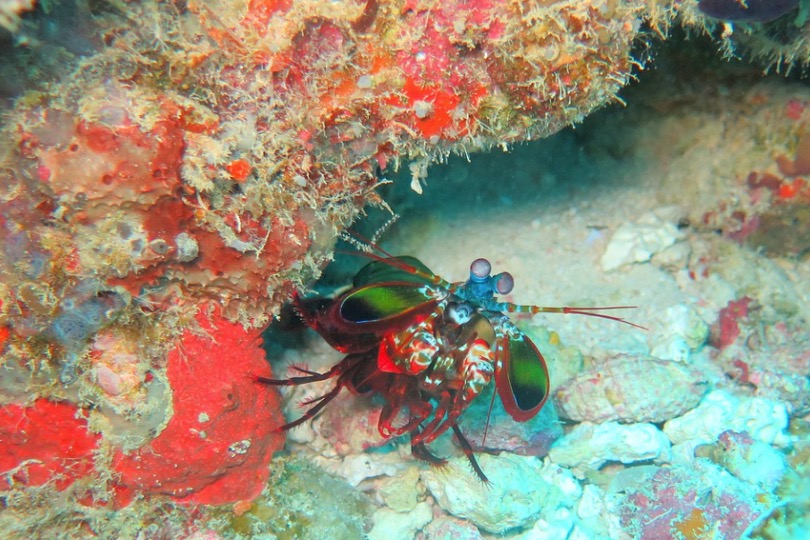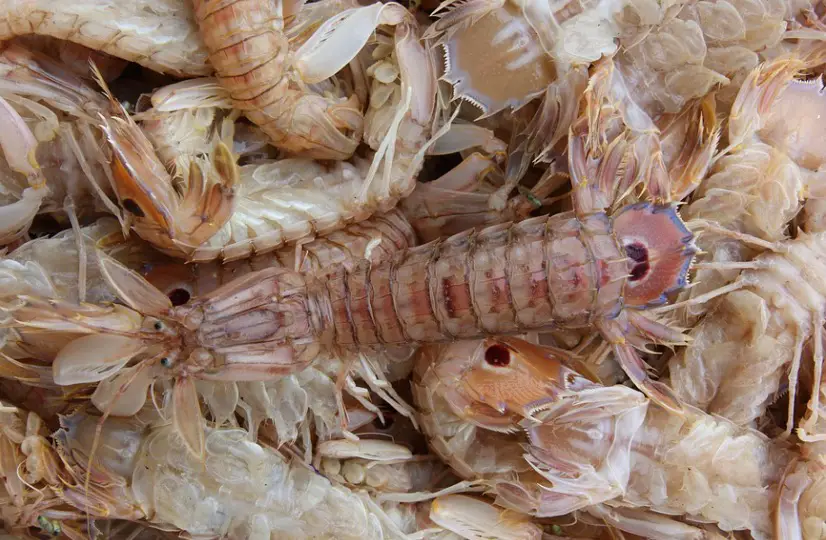Table of Contents
Mantis Shrimp: All You Need To Know
A mantis shrimp is a marine predator species that belongs to the kingdom of Animalia, phylum Chordata/subphylum Crustacea, and class Malacostraca. It has many genera and 451 different species. Its length is 10 to 38 cm and it weighs about 12 to 90 g. It lives in the sediment or Coral Reef Burrows, with a lifespan of up to 20 years.

Mantis Shrimp Description
Shrimp species known as mantis shrimp are a fascinating genus of shrimp. Mantis shrimp are genuine predators, whereas other shrimp species graze on small creatures or scavenge on dead organisms. Mantis shrimp have modified forelimbs that allow them to spear or stun their prey, and this trait divides them into subgroups.
These forelimbs are used as clubs by “smashers.” Because these enhanced forelimbs have so much strength, they can produce forces that are unrivalled in the animal world. In a fraction of a second, the club may reach speeds of over 50 mph. This produces a force of almost 1,500 newtons, which is equivalent to a 340-pound item landing on the victim!
However, the club’s acceleration generates a sound wave that slams into the victim shortly after the real club. Smashers now have a “1-2 punch” that can paralyse considerably larger victims.

“Spearers,” on the other hand, have sharp spikes on their limbs that they use to impale tiny fish and other food. Spearers are also capable of striking with incredible speed and precision. Spearers, unlike Smashers, like to dwell in soft substrates like sand.
They wait for an unfortunate fish to swim past before impaling it at breakneck speed. The majority of mantis shrimp have stunning colouring that may be used for both concealment and communication. Some species are darkly or drably coloured, allowing them to blend in with the seabed.
Others, such as the peacock mantis shrimp, utilise brilliant warning colours to ward off predators. If that doesn’t work, their devastating strike can harm or scare away a large number of prospective predators.
Fun Facts About Mantis Shrimp!
As if studying the Mantis Shrimp wasn’t interesting enough, they can also teach us a lot about larger biological principles.
Mantis Shrimp Hunting Adaptations
Smashers and Spearers, two different species of mantis shrimp, demonstrate how versatile crustaceans can be. Though mantis shrimp originated from a similar progenitor over 200 million years ago, their front appendages serve quite distinct purposes.
Smashers just hit prey with the direct force of their mantis-like front legs, whereas Spearers have sharp barbs on their limbs that impale and catch their victim. As a result, the two groups tend to concentrate on distinct types of prey. Spearers prefer fish that are soft and meaty.
Smashers go for tougher prey, including other crustaceans, snails, and oysters. Their club-like arms may tear apart these creatures’ shells to gain access to the nutrients inside.
This variation in prey kind and use might have been the catalyst for speciation in this group. Mantis shrimp are found in coastal locations all over the world, and there are approximately 450 distinct species.
Mantis Shrimp's Compound Eye
Mantis shrimp have another adaption that makes them excellent predators, in addition to their amazing weapon-like limbs. Compound eyes are seen in many arthropods, including mantis shrimp. Compound eyes are comparable to human eyes in function, yet they are built quite differently.
Instead of a single lens focusing light into the retina, these eyes’ receptor cells are located right on the surface. Mantis shrimp, on the other hand, have the most sophisticated and functioning compound eyes of any animal ever investigated.
Mantis shrimp have up to 16 distinct types of cells in their eyes, but humans only have three types of cells that can sense different colours and wavelengths of light. As a result, mantis shrimp are believed to be able to perceive a wide range of wavelengths that are invisible to humans.
This indicates that mantis shrimp can sense infrared and ultraviolet light, both of which are invisible to humans. This incredible talent also explains why mantis shrimp are frequently vividly coloured.
Coloration as Communication
Many animals use their colours to communicate. Bees and many insects, for example, have “warning colouring” that allows other animals to recognise them as harmful. Peacocks, for example, have created vibrant colour schemes to attract mates. More colourful partners are chosen throughout time, resulting in highly colourful males or females.
Mantis shrimp appear to use a combination of both. Their vivid colouring serves as a warning to would-be predators that they are dangerous. Researchers have discovered that mantis shrimp may use their colour to attract mates and communicate with other mantis shrimp.
Some species have biofluorescence, which they can utilise to warn their partners or other shrimp intruding on their territory. These shrimp can detect patterns and hues of light that aren’t apparent to the naked eye because of their incredible compound eyes.
While scientists know that these shrimp communicate using coloured signals, the techniques and procedures by which they do so are still unknown. This is mostly due to the fact that we require sophisticated scientific tools to determine what light mantis shrimp exhibit and how they interpret light signals.
Mantis Shrimp Citations
- Smashing mantis shrimp strategically impact shells. J Exp Biol . 2018 Jun 14;221(Pt 11):jeb176099.
- Mantis Shrimp Navigate Home Using Celestial and Idiothetic Path Integration. Curr Biol . 2020 Jun 8;30(11):1981-1987.e3.
- Zebra Mantis Shrimp. Ophthalmology . 2021 Jan;128(1):129.
- Landmark navigation in a mantis shrimp. Proc Biol Sci . 2020 Oct 14;287(1936):20201898.







